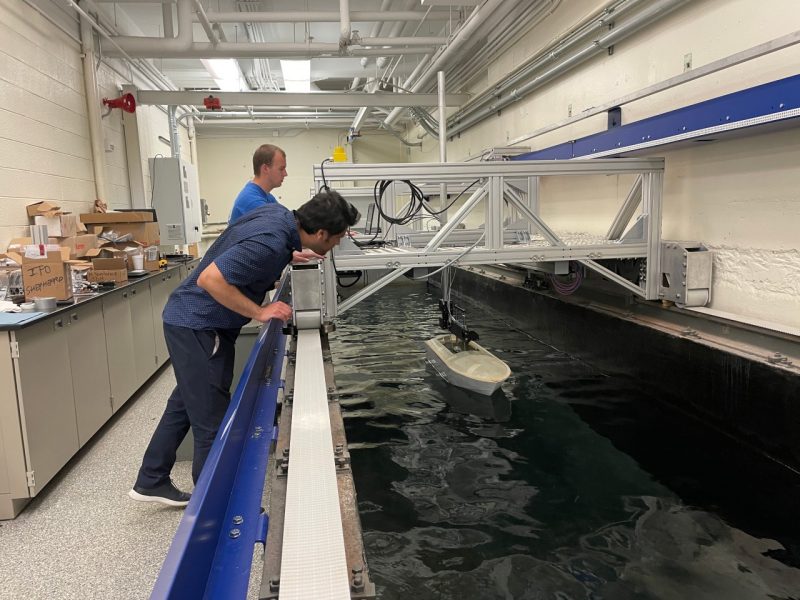
By Jama Green
Tucked away deep in the basement of Norris Hall, Virginia Tech’s 60-year-old towing tank was in desperate need of a face-lift. The basin and its towing carriage, primarily used for ship resistance research, was showing its age.
In late 2018, Associate Professor Christine Gilbert and Professor Craig Woolsey of the Kevin T. Crofton Department of Aerospace and Ocean Engineering secured $620,000 from the Office of Naval Research through the Defense University Research Instrumentation Program.
The resulting instrumentation upgrade modernized the aging tow tank to provide Virginia Tech with a unique testing facility to perform innovative, nontraditional experiments that will serve the U.S. Department of Defense.
As one of a dozen or so academic towing tanks in the United States, the upgraded tank at Virginia Tech gives undergraduate and graduate engineering students valuable experience in state-of-the-art facilities, training on cutting-edge technologies, and ultimately the opportunity to work to advance military research, which plays a critical role in workforce development.
The facility is located near several U.S. Navy and commercial facilities in the mid-Atlantic region, notably in Washington, D.C., and Norfolk, that regularly hire Virginia Tech engineers to support the Department of Defense mission.
Experimental towing tank facilities are used by naval architects and engineers to conduct physical model experiments in a controlled environment. While they vary in size and length, these facilities typically consist of a meters-long basin with a towing carriage mounted on rails above the tank, which pulls a model through the water at high speed.
Researchers are able to test small-scale models of ships and ocean engineering vehicles and instrumentation and capture data on hydrodynamics such as drag, lift, and force of flow while studying the effects that waves have on the vehicle’s structure.
“Students are going to be able to use the new towing tank facility to gain foundational knowledge, whether they gain this opportunity through undergraduate or graduate research projects, independent study, and curricular or competitive engineering design,” said Gilbert. “The experience working on towing tank experiments at Virginia Tech is valuable job training for experimental work being performed in the field and at naval laboratories.”
Virginia Tech began working with DLBA (a division of Gibbs & Cox) in partnership with Edinburgh Designs on trade studies for the carriage upgrade starting in 2019. The former towing carriage was removed and has been replaced with a high-speed simple frame design that no longer requires researchers and students to ride on the carriage. The carriage is now remotely operated, equipped with cameras for monitoring, and boasts smoother carriage movement along its rails and a more precisely controlled carriage speed.
The carriage itself is capable of a constant maximum velocity of 7 meters per second (or 23 feet per second). The carriage is propelled with a belt-driven system with one large electric motor on each rail. The brakes are electromagnetic, providing enough braking force for the high acceleration and deceleration loads.
Further additions to the towing tank include a dedicated data acquisition system and a suite of new sensors for experiments, such as force gauges, accelerometers, potentiometers, wave probes, inclinometers, and pressure sensors.




